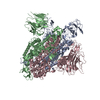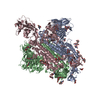+ Open data
Open data
- Basic information
Basic information
| Entry | Database: PDB / ID: 6xs6 | |||||||||||||||||||||||||||||||||
|---|---|---|---|---|---|---|---|---|---|---|---|---|---|---|---|---|---|---|---|---|---|---|---|---|---|---|---|---|---|---|---|---|---|---|
| Title | SARS-CoV-2 Spike D614G variant, minus RBD | |||||||||||||||||||||||||||||||||
 Components Components | Spike glycoprotein | |||||||||||||||||||||||||||||||||
 Keywords Keywords | VIRAL PROTEIN / SARS-CoV-2 / Spike / D614G | |||||||||||||||||||||||||||||||||
| Function / homology |  Function and homology information Function and homology informationsymbiont-mediated disruption of host tissue / Maturation of spike protein / Translation of Structural Proteins / Virion Assembly and Release / host cell surface / host extracellular space / viral translation / symbiont-mediated-mediated suppression of host tetherin activity / Induction of Cell-Cell Fusion / structural constituent of virion ...symbiont-mediated disruption of host tissue / Maturation of spike protein / Translation of Structural Proteins / Virion Assembly and Release / host cell surface / host extracellular space / viral translation / symbiont-mediated-mediated suppression of host tetherin activity / Induction of Cell-Cell Fusion / structural constituent of virion / membrane fusion / entry receptor-mediated virion attachment to host cell / Attachment and Entry / host cell endoplasmic reticulum-Golgi intermediate compartment membrane / positive regulation of viral entry into host cell / receptor-mediated virion attachment to host cell / host cell surface receptor binding / symbiont-mediated suppression of host innate immune response / receptor ligand activity / endocytosis involved in viral entry into host cell / fusion of virus membrane with host plasma membrane / fusion of virus membrane with host endosome membrane / viral envelope / symbiont entry into host cell / virion attachment to host cell / SARS-CoV-2 activates/modulates innate and adaptive immune responses / host cell plasma membrane / virion membrane / identical protein binding / membrane / plasma membrane Similarity search - Function | |||||||||||||||||||||||||||||||||
| Biological species |  | |||||||||||||||||||||||||||||||||
| Method | ELECTRON MICROSCOPY / single particle reconstruction / cryo EM / Resolution: 3.7 Å | |||||||||||||||||||||||||||||||||
 Authors Authors | Wang, X. / Egri, S.B. / Dudkina, N. / Luban, J. / Shen, K. | |||||||||||||||||||||||||||||||||
| Funding support |  United States, 3items United States, 3items
| |||||||||||||||||||||||||||||||||
 Citation Citation |  Journal: Cell / Year: 2020 Journal: Cell / Year: 2020Title: Structural and Functional Analysis of the D614G SARS-CoV-2 Spike Protein Variant. Authors: Leonid Yurkovetskiy / Xue Wang / Kristen E Pascal / Christopher Tomkins-Tinch / Thomas P Nyalile / Yetao Wang / Alina Baum / William E Diehl / Ann Dauphin / Claudia Carbone / Kristen ...Authors: Leonid Yurkovetskiy / Xue Wang / Kristen E Pascal / Christopher Tomkins-Tinch / Thomas P Nyalile / Yetao Wang / Alina Baum / William E Diehl / Ann Dauphin / Claudia Carbone / Kristen Veinotte / Shawn B Egri / Stephen F Schaffner / Jacob E Lemieux / James B Munro / Ashique Rafique / Abhi Barve / Pardis C Sabeti / Christos A Kyratsous / Natalya V Dudkina / Kuang Shen / Jeremy Luban /   Abstract: The SARS-CoV-2 spike (S) protein variant D614G supplanted the ancestral virus worldwide, reaching near fixation in a matter of months. Here we show that D614G was more infectious than the ancestral ...The SARS-CoV-2 spike (S) protein variant D614G supplanted the ancestral virus worldwide, reaching near fixation in a matter of months. Here we show that D614G was more infectious than the ancestral form on human lung cells, colon cells, and on cells rendered permissive by ectopic expression of human ACE2 or of ACE2 orthologs from various mammals, including Chinese rufous horseshoe bat and Malayan pangolin. D614G did not alter S protein synthesis, processing, or incorporation into SARS-CoV-2 particles, but D614G affinity for ACE2 was reduced due to a faster dissociation rate. Assessment of the S protein trimer by cryo-electron microscopy showed that D614G disrupts an interprotomer contact and that the conformation is shifted toward an ACE2 binding-competent state, which is modeled to be on pathway for virion membrane fusion with target cells. Consistent with this more open conformation, neutralization potency of antibodies targeting the S protein receptor-binding domain was not attenuated. #1:  Journal: Biorxiv / Year: 2020 Journal: Biorxiv / Year: 2020Title: Structural and Functional Analysis of the D614G SARS-CoV-2 Spike Protein Variant Authors: Yurkovetskiy, L. / Wang, X. / Pascal, K.E. / Tompkins-Tinch, C. / Nyalile, T. / Wang, Y. / Baum, A. / Diehl, W.E. / Dauphin, A. / Carbone, C. / Veinotte, K. / Egri, S.B. / Schaffner, S.F. / ...Authors: Yurkovetskiy, L. / Wang, X. / Pascal, K.E. / Tompkins-Tinch, C. / Nyalile, T. / Wang, Y. / Baum, A. / Diehl, W.E. / Dauphin, A. / Carbone, C. / Veinotte, K. / Egri, S.B. / Schaffner, S.F. / Lemieux, J.E. / Munro, J. / Rafique, A. / Barve, A. / Sabeti, P.C. / Kyratsous, C. / Dudkina, N. / Shen, K. / Luban, J. | |||||||||||||||||||||||||||||||||
| History |
|
- Structure visualization
Structure visualization
| Movie |
 Movie viewer Movie viewer |
|---|---|
| Structure viewer | Molecule:  Molmil Molmil Jmol/JSmol Jmol/JSmol |
- Downloads & links
Downloads & links
- Download
Download
| PDBx/mmCIF format |  6xs6.cif.gz 6xs6.cif.gz | 435.2 KB | Display |  PDBx/mmCIF format PDBx/mmCIF format |
|---|---|---|---|---|
| PDB format |  pdb6xs6.ent.gz pdb6xs6.ent.gz | 337.1 KB | Display |  PDB format PDB format |
| PDBx/mmJSON format |  6xs6.json.gz 6xs6.json.gz | Tree view |  PDBx/mmJSON format PDBx/mmJSON format | |
| Others |  Other downloads Other downloads |
-Validation report
| Summary document |  6xs6_validation.pdf.gz 6xs6_validation.pdf.gz | 926.8 KB | Display |  wwPDB validaton report wwPDB validaton report |
|---|---|---|---|---|
| Full document |  6xs6_full_validation.pdf.gz 6xs6_full_validation.pdf.gz | 940.6 KB | Display | |
| Data in XML |  6xs6_validation.xml.gz 6xs6_validation.xml.gz | 62.8 KB | Display | |
| Data in CIF |  6xs6_validation.cif.gz 6xs6_validation.cif.gz | 95.8 KB | Display | |
| Arichive directory |  https://data.pdbj.org/pub/pdb/validation_reports/xs/6xs6 https://data.pdbj.org/pub/pdb/validation_reports/xs/6xs6 ftp://data.pdbj.org/pub/pdb/validation_reports/xs/6xs6 ftp://data.pdbj.org/pub/pdb/validation_reports/xs/6xs6 | HTTPS FTP |
-Related structure data
| Related structure data |  22301MC M: map data used to model this data C: citing same article ( |
|---|---|
| Similar structure data |
- Links
Links
- Assembly
Assembly
| Deposited unit | 
|
|---|---|
| 1 |
|
- Components
Components
| #1: Protein | Mass: 139258.344 Da / Num. of mol.: 3 Source method: isolated from a genetically manipulated source Source: (gene. exp.)  Gene: S, 2 / Production host:  Homo sapiens (human) / References: UniProt: P0DTC2 Homo sapiens (human) / References: UniProt: P0DTC2Has protein modification | Y | |
|---|
-Experimental details
-Experiment
| Experiment | Method: ELECTRON MICROSCOPY |
|---|---|
| EM experiment | Aggregation state: PARTICLE / 3D reconstruction method: single particle reconstruction |
- Sample preparation
Sample preparation
| Component | Name: SARS2 Spike D614G / Type: COMPLEX / Entity ID: all / Source: RECOMBINANT |
|---|---|
| Molecular weight | Value: 417 kDa/nm / Experimental value: YES |
| Source (natural) | Organism:  |
| Source (recombinant) | Organism:  Homo sapiens (human) Homo sapiens (human) |
| Buffer solution | pH: 7.4 |
| Specimen | Embedding applied: NO / Shadowing applied: NO / Staining applied: NO / Vitrification applied: YES |
| Vitrification | Cryogen name: ETHANE |
- Electron microscopy imaging
Electron microscopy imaging
| Experimental equipment |  Model: Titan Krios / Image courtesy: FEI Company |
|---|---|
| Microscopy | Model: FEI TITAN KRIOS |
| Electron gun | Electron source:  FIELD EMISSION GUN / Accelerating voltage: 300 kV / Illumination mode: OTHER FIELD EMISSION GUN / Accelerating voltage: 300 kV / Illumination mode: OTHER |
| Electron lens | Mode: OTHER |
| Image recording | Electron dose: 0.6 e/Å2 / Film or detector model: OTHER |
- Processing
Processing
| Software | Name: PHENIX / Version: 1.18.2_3874: / Classification: refinement | ||||||||||||||||||||||||
|---|---|---|---|---|---|---|---|---|---|---|---|---|---|---|---|---|---|---|---|---|---|---|---|---|---|
| EM software | Name: PHENIX / Category: model refinement | ||||||||||||||||||||||||
| CTF correction | Type: NONE | ||||||||||||||||||||||||
| Symmetry | Point symmetry: C3 (3 fold cyclic) | ||||||||||||||||||||||||
| 3D reconstruction | Resolution: 3.7 Å / Resolution method: FSC 0.143 CUT-OFF / Num. of particles: 266302 / Symmetry type: POINT | ||||||||||||||||||||||||
| Atomic model building | Protocol: AB INITIO MODEL | ||||||||||||||||||||||||
| Refine LS restraints |
|
 Movie
Movie Controller
Controller











 PDBj
PDBj



